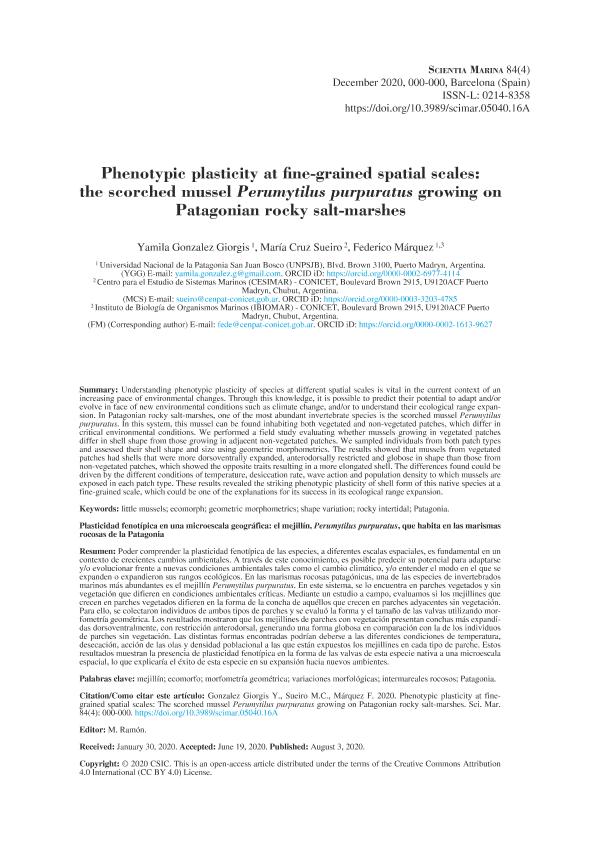Mostrar el registro sencillo del ítem
dc.contributor.author
González Giorigis, Yamila
dc.contributor.author
Sueiro, Maria Cruz

dc.contributor.author
Marquez, Federico

dc.date.available
2021-07-23T14:04:12Z
dc.date.issued
2020-08
dc.identifier.citation
González Giorigis, Yamila; Sueiro, Maria Cruz; Marquez, Federico; Phenotypic plasticity at fine-grained spatial scales: the scorched mussel Perumytilus purpuratus growing on Patagonian rocky salt-marshes; Institut de Ciències del Mar (CSIC); Scientia Marina; 84; 4; 8-2020
dc.identifier.issn
0214-8358
dc.identifier.uri
http://hdl.handle.net/11336/136739
dc.description.abstract
Understanding phenotypic plasticity of species at different spatial scales is vital in the current context of an increasing pace of environmental changes. Through this knowledge, it is possible to predict their potential to adapt and/or evolve in face of new environmental conditions such as climate change, and/or to understand their ecological range expansion. In Patagonian rocky salt-marshes, one of the most abundant invertebrate species is the scorched mussel Perumytilus purpuratus. In this system, this mussel can be found inhabiting both vegetated and non-vegetated patches, which differ in critical environmental conditions. We performed a field study evaluating whether mussels growing in vegetated patches differ in shell shape from those growing in adjacent non-vegetated patches. We sampled individuals from both patch types and assessed their shell shape and size using geometric morphometrics. The results showed that mussels from vegetated patches had shells that were more dorsoventrally expanded, anterodorsally restricted and globose in shape than those from non-vegetated patches, which showed the opposite traits resulting in a more elongated shell. The differences found could be driven by the different conditions of temperature, desiccation rate, wave action and population density to which mussels are exposed in each patch type. These results revealed the striking phenotypic plasticity of shell form of this native species at a fine-grained scale, which could be one of the explanations for its success in its ecological range expansion.
dc.description.abstract
Poder comprender la plasticidad fenotípica de las especies, a diferentes escalas espaciales, es fundamental en un contexto de crecientes cambios ambientales. A través de este conocimiento, es posible predecir su potencial para adaptarse y/o evolucionar frente a nuevas condiciones ambientales tales como el cambio climático, y/o entender el modo en el que se expanden o expandieron sus rangos ecológicos. En las marismas rocosas patagónicas, una de las especies de invertebrados marinos más abundantes es el mejillín Perumytilus purpuratus. En este sistema, se lo encuentra en parches vegetados y sin vegetación que difieren en condiciones ambientales críticas. Mediante un estudio a campo, evaluamos si los mejillines que crecen en parches vegetados difieren en la forma de la concha de aquéllos que crecen en parches adyacentes sin vegetación. Para ello, se colectaron individuos de ambos tipos de parches y se evaluó la forma y el tamaño de las valvas utilizando morfometría geométrica. Los resultados mostraron que los mejillines de parches con vegetación presentan conchas más expandidas dorsoventralmente, con restricción anterodorsal, generando una forma globosa en comparación con la de los individuos de parches sin vegetación. Las distintas formas encontradas podrían deberse a las diferentes condiciones de temperatura, desecación, acción de las olas y densidad poblacional a las que están expuestos los mejillines en cada tipo de parche. Estos resultados muestran la presencia de plasticidad fenotípica en la forma de las valvas de esta especie nativa a una microescala espacial, lo que explicaría el éxito de esta especie en su expansión hacia nuevos ambientes.
dc.format
application/pdf
dc.language.iso
eng
dc.publisher
Institut de Ciències del Mar (CSIC)
dc.rights
info:eu-repo/semantics/openAccess
dc.rights.uri
https://creativecommons.org/licenses/by/2.5/ar/
dc.subject
LITTLE MUSSELS
dc.subject
ECOMORPH
dc.subject
GEOMETRIC MORPHOMETRICS
dc.subject
ROCKY INTERTIDAL
dc.subject
PATAGONIA
dc.subject
MEJILLÍN
dc.subject
ECOMORFO
dc.subject
MORFOMETRÍA GEOMÉTRICA
dc.subject
VARIACIONES MORFOLÓGICAS
dc.subject
INTERMAREALES ROCOSOS
dc.subject.classification
Ecología

dc.subject.classification
Ciencias Biológicas

dc.subject.classification
CIENCIAS NATURALES Y EXACTAS

dc.title
Phenotypic plasticity at fine-grained spatial scales: the scorched mussel Perumytilus purpuratus growing on Patagonian rocky salt-marshes
dc.title
Plasticidad fenotípica en una microescala geográfica: el mejillín, Perumytilus purpuratus, que habita en las marismas rocosas de la Patagonia
dc.type
info:eu-repo/semantics/article
dc.type
info:ar-repo/semantics/artículo
dc.type
info:eu-repo/semantics/publishedVersion
dc.date.updated
2020-09-25T16:47:20Z
dc.identifier.eissn
1886-8134
dc.journal.volume
84
dc.journal.number
4
dc.journal.pais
España

dc.journal.ciudad
Barcelona
dc.conicet.avisoEditorial
© 2020 CSIC. This is an open-access article distributed under the terms of the Creative Commons Attribution 4.0 International (CC BY 4.0) License.
dc.description.fil
Fil: González Giorigis, Yamila. Universidad Nacional de la Patagonia "San Juan Bosco"; Argentina
dc.description.fil
Fil: Sueiro, Maria Cruz. Consejo Nacional de Investigaciones Científicas y Técnicas. Centro Científico Tecnológico Conicet - Centro Nacional Patagónico. Centro para el Estudio de Sistemas Marinos; Argentina
dc.description.fil
Fil: Marquez, Federico. Consejo Nacional de Investigaciones Científicas y Técnicas. Centro Científico Tecnológico Conicet - Centro Nacional Patagónico. Instituto de Biología de Organismos Marinos; Argentina
dc.journal.title
Scientia Marina

dc.relation.alternativeid
info:eu-repo/semantics/altIdentifier/doi/https://doi.org/10.3989/scimar.05040.16A
dc.relation.alternativeid
info:eu-repo/semantics/altIdentifier/url/https://scientiamarina.revistas.csic.es/index.php/scientiamarina/article/view/1878
Archivos asociados
